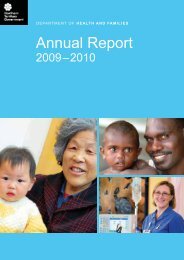PCD Strategy Evaluation 2007.pdf - NT Health Digital Library ...
PCD Strategy Evaluation 2007.pdf - NT Health Digital Library ...
PCD Strategy Evaluation 2007.pdf - NT Health Digital Library ...
You also want an ePaper? Increase the reach of your titles
YUMPU automatically turns print PDFs into web optimized ePapers that Google loves.
also manage a small load of six to eight advanced kidney disease patients and have moreengagement with community organisations through sharing information and resources (63) .Aboriginal <strong>Health</strong> Worker PositionsIn June 2007, Remote <strong>Health</strong> has started to recruit to the vacant AHW positions with peoplededicated to program work, of which chronic disease is a high priority. There are also a numberof AHW‟s who achieved Certificate IV in Diabetes and Cardiovascular Disease in 2005-06. Thetraining was delivered by <strong>Health</strong>y Living <strong>NT</strong> and <strong>PCD</strong> team have assisted those AHW incompleting their coursework for accreditation. The main barrier identified is health centremanagers requiring AHW‟s to continue to participate in acute care rather than solely working inchronic disease programs (63) .The establishment of the public health nurses and the <strong>PCD</strong> teams has provided leadership forchronic disease activities in remote areas and increased the capacity to deliver screening andchronic disease care. The <strong>PCD</strong> team have assisted remote services to update the systems thatsupport a planned approach to screening and prevention. At most remote sites staff reportedthey are overwhelmed with the acute workloads in clinics and that it often falls to the Public<strong>Health</strong> Nurse to do follow up and the Aboriginal <strong>Health</strong> Workers on the <strong>PCD</strong> team to initiate anddrive screening activities. A similar relationship has not been established with urban communityhealth services. Interviews in the urban community health services revealed that there was verylittle interaction or collaboration with the <strong>PCD</strong> team.3.4.3 Chronic Disease Programs in non-<strong>NT</strong>DH&CS clinicsIn June 2004, <strong>Health</strong>y Living <strong>NT</strong> received funding from the <strong>NT</strong>DH&CS to provide education andtraining to selected non-government health clinics throughout the Northern Territory. Thisprogram ran until December 2004 in ten clinics across the Top End (38) . This program found: In the majority of clinics, staff appeared vague about care plans and required furtherexplanation Chronic disease management took a low priority to acute cases either due to lack of time orinadequate staffing Three clinics stated they had 100 per cent of chronic disease clients managed under careplans; one clinic stated it had 75 per cent; and one clinic estimated it had 10 per cent Four clinics could not give the information or did not know. However one of these clinicsadvised that it had just appointed a person dedicated to chronic disease, andChapter 3: Progress Against <strong>PCD</strong>S Objectives – <strong>Evaluation</strong> of the <strong>NT</strong> Preventable Chronic Disease <strong>Strategy</strong> 2007 52
















